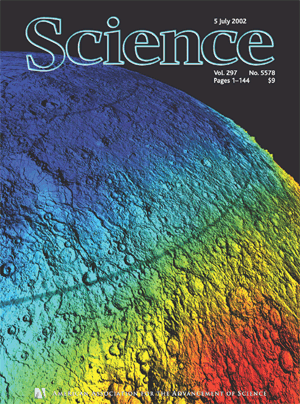Work-Related Links

Work-Related Links |
 |
Read about our Newest Results.
The Gamma Ray Spectrometer is located on the end of a 6-meter fiberglass boom. On 04 June, the boom was deployed. We had been collecting data close in to the spacecraft since the mapping mission began. As soon as the detector cools off, we will again look at Mars. Except for (very small) seasonal differences, the way the signal changes will be due to a decrease in the contribution (noise) from the spacecraft. Cosmic rays hit the spacecraft and produce gamma rays that register in our detector. By getting further away from the spacecraft, we “hear” it less. For example, we expect to see the aluminum component of the signal to decrease.
Measurements at the two positions and the inverse-square law allow us to estimate what the total signal would be if we were infinitely far away from the spacecraft. Boom deployment is not reversible.
Recently, the detector completed a warm anneal to heal radiation
damage accumulated during cruise and the approximately 220 days
in orbit around Mars. The first post-anneal data came down on 22 May.
The resolution of the detector is significantly improved, meaning
fainter lines can be detected in shorter integration time. Here’s
a sample:

Recently, I have been tasked with deriving/calculating essentially all of the geometric factors affecting GRS data analysis and reductions. The following links will lead you on a guided tour of some of the issues we must address for proper data analysis:
One of the first results of the Mars Odyssey GRS experiment is a map of epithermal neutrons from the surface of Mars. Refer to the figure below. You can see that near the south pole there is a marked drop in the flux of neutrons detected (dark blue region). Something is moderating (slowing down) these neutrons; what can that something be?

The most efficient way to moderate neutrons is to have them collide with something comparable in mass to them. A neutron’s mass is 1 AMU, and so is the mass of a hygrogen atom. The only element to bind with hydrogen in great numbers on the terrestrial planets is oxygen. 1 oxygen + 2 hydrogens = water. Thus, from the GRS Neutron Spectrometer results, we infer that a large reservoir of subsurface ice exists at Mars’s south pole. The detection is indirect, but a real smoking gun: no other reasonable explanation has been proposed.
How much ice? Well, preliminary analysis indicates about 6 weight-percent of the first half-meter from the surface is ice.

Theoretical modelling of the Martian environment over several Milankovic cycles by Mellon and Jakowsky has led to predictions as to how deep below the surface one has to go before water becomes stable. The next Figure shows the 80-cm depth stability contour superposed on Odyssey’s Neutron Spectrometer epithermal neutron data. Water ice is predicted to be stable poleward of the contour lines. It is interesting to note that the model is consistent with our data, particularly since the effective depth of the epithermal neutron signal is about 50 cm. (The map projection is Robinson.)

The first round of papers detailing our results appeared in the 05 July issue of Science. We even made the cover:

Boynton, W.V., Feldman, W.C., Squyres, S.W., Prettyman, T., Brückner, J., Evans, L.G., Reedy, R.C., Starr, R., Arnold, J.R., Drake, D.M., Englert, P.A.J., Metzger, A.E., Mitrofanov, I., Trombka, J.I., d’Uston, C., Wänke, H., Gasnault, O., Hamara, D., Janes, D.M., Marcialis, R.L., Maurice, S., Mikheeva, I., Taylor, G.J., Tokar, R., and Shinohara, C.
(2002)
Distribution of hydrogen in the near-surface of Mars: evidence for sub-surface
ice deposits. Science 297,
Other abstracts and papers have been submitted, and the science continues to roll in:
Boynton, W.V., Hamara, D.K., Feldman, W.A., Prettyman, T.H., and Team, M.O.G.R.S. (2002) Subsurface ice content in the north polar region of Mars. Bull. Amer. Astron. Soc. 34, no. 3, in press. (Abstract) GRS DPS abstract
Mitrofanov, I.G., Anfimov, D.S., Kozyrev, A.S., Litvak, M.L., Sanin, A.B., Tret’yakov, V.I., Boynton, W.V., Shinohara, C., Hamara, D., Saunders, R.S., Team, H.E.N.D., Team, G.R.S., and Team, O. (2002) The stable and variable features of subsurface water on Mars: HEND data from Odyssey. Bull. Amer. Astron. Soc. 34, no. 3, in press. (Abstract) HEND DPS abstract
Boynton, W.V., et al. (2002) Subsurface ice content in the polar region of Mars: comparison between north and south. Eos, in press. (Abstract) GRS AGU abstract
Boynton, W.V., Feldman, W.C., Mitrofanov, I.G., Evans, L.G., Reedy, R.C., Squyres, S.W., Starr, R., Trombka, J.I., d’Uston, C., Arnold, J.R., Englert, P.A.J., Metzger, A.E., Wänke, H., Brückner, J., Drake, D.M., Shinohara, C.R., Fellows, C., Hamara, D.K., Harshman, K., Turner, C., Barthe, H., Fuller, K.R., Storms, S.A., Thornton, G.W., Longmire, J.L., Litvak, M.L., and Ton’chev, A.K. (2002) The Mars Odyssey Gamma-Ray Spectrometer instrument suite. Space Science Reviews, submitted.
N.B.: Many of our team have been relegated to mention in either the Acknowledgements section of these papers, or included under the umbrella name “Team, G.R.S.”. This is not typically done for papers describing an instrument build, verification, calibration, and delivery, nor for the first few results papers. However, it is the prerogative of the first author to decide these matters. The rest of us worker drones toil on.
In the last few months a hydrogen signature in the north polar region has appeared and is growing. It is now springtime in the northern hemisphere, and as the north warms up, its CO2 (carbon dioxide, or dry ice) polar cap sublimes to atmospheric gas. Underlying this cap, additional water ice becomes uncovered.
A water source near the north pole is great news for future manned exploration of Mars. It now means two volatile reservoirs, at opposite ends of the planet. For any mission predicated on mining local water for consumption and fueling the ride back home, this increases the flexibility of landing site selection.
This Web page is maintained by
Bob Marcialis
Copyright © 2002 Robert L. Marcialis
![]()
Last Modified: 2002 September 17